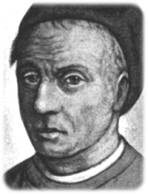Home
Authors
Titles
Keyword Search
Reference
|
One of the leading Christian mystics of the late middle ages, Thomas á Kempis was born in Kempen (hence the origin of his appelation "á Kempis"), near Köln (Cologne), Germany, in 1380. His original name was Thomas Hemerken, or Hammerlein (meaning "little hammer.") He was educated in the school in Deventer (Netherlands) run by the Brethren of the Common Life. Later he entered the Augustinian Convent of Mount Saint Agnes, near Zwolle, which was a daughter house of the monastery of Windesheim, of which his brother, John, was prior. Thomas was ordained a priest in 1413 and became subprior in 1429. He remained in the same monastery for the rest of his life. Thomas' main job was copying manuscripts, and he is said to have copied the whole Bible at least four times. One of Thomas' copies of the Bible, bound in five volumes, is preserved in Darmstadt, Germany. Thomas was much in demand as a spiritual director. His methods followed those of Gerard Groote and Florentius Radewijns, the founders of the Brethren of the Common Life. Thomas' writings are all of a devotional character and include tracts and meditations, letters, sermons, a life of Saint Lydewigis—a Christian woman who remained steadfast under a great stress of afflictions—and biographies of Groote, Radewijns, and nine of their companions; but his reputation rests on his most famous work, The Imitation of Christ. The title is derived from the Latin title of the first book, De imitatione Christi et contemptu omnium vanitatum mundi (Of the imitation of Christ, and of contempt of the world and all its vanities). Works similar in content to The Imitation of Christ are his prolonged meditation on the life and blessings of the Savior and another on the Incarnation. Both of these works overflow with adoration for Christ. The Imitation of Christ is a manual of devotion designed to help the soul achieve holiness and communion with God. It was first published anonymously, in Latin, around 1418. Over the centuries, some scholars have suggested that the book may have been written by several other authors, but Thomas' authorship is now generally accepted. Some of the themes stressed are typical of later Roman Catholic devotional practice. What has made the work so popular among Christians of all traditions is its supreme stress on Christ and fellowship with Him. Along with the Confessions of St. Augustine and John Bunyan's Pilgrim's Progress it is ranked among the greatest of Christian devotional literature. Protestants and Roman Catholics alike join in giving it praise. The Jesuits officially refer to it in their "exercises." John Wesley and John Newton put it among the works that influenced them at their conversions. The renowned Christian and British General Charles George Gordon carried it with him to the battlefield. The number of counted editions exceeds 2,000; and it is one of the most translated works of all time. The Classical Library, This HTML edition copyright ©2006. |
Home
Authors
Titles
Keyword Search
Reference
 Thomas á Kempis(1380-1471)
Thomas á Kempis(1380-1471)